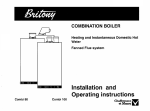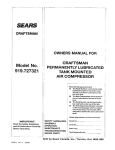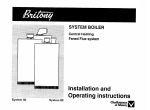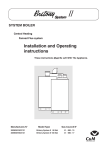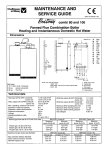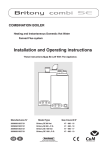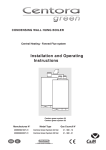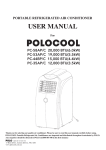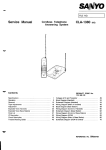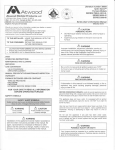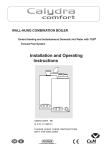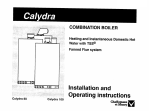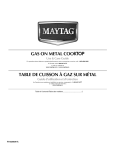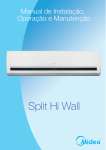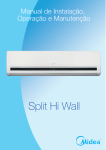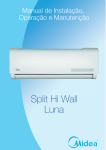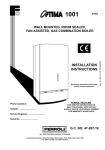Download Installation and Operating instructions
Transcript
SYSTEM PLUS BOILER Heating boiler compatible with indirect cylinder Faned Flue system Installation and Operating instructions System plus 40 System plus 60 =~e~~~ v u These instructions are suitable for the following boilers : BRITONY System plus 40 BRITONY System plus 60 CUSTOMER CARE Chaffoteaux et Maury Ltd , as a leading manufacturer of domestic and commerctal water heating appliances, is committed to providing high quality products and a high qualrty after sales service If it is necessary to contact an engineer, then telephone your local Chaffoteaux Service Centre The number can be obtained from the leaflet enclosed in the customer care pack with your boiler or by telephoning the Chaffoteaux Customer Services Department at Telford. Advrce on installatron or servicing can also be obtained by contacting the Chaffoteaux Customer Services Department at Telford CUSTOMER SERVICES DEPARTMENT Tel 01952 222288 Fax 01952260915 GUARANTEE The manuiacturer’s guarantee IS for 12 months from the date of purchase. The guarantee is voidable if the appliance is not installed in accordance with the recommendations made herem or in a manner not approved by the manufacturer To assist us in providing you with an efficient after sales service, please return the guarantee regtstratron card enclosed with the boiler without delay STATUTORY REQUIREMENTS The installation of this appltance must be carried out by a Safety (Installatton and Use) Regulations Registered or other competent person and in accordance requirements of the Gas In addition, the installation must also comply with the current byelaws of Local Water Undertakings, Building Regulations, IEE Wiring Regulations, Local Authority Building Standards (Scotland) Regulations and the Safety Document 635 The Electricity at work Regulation. It should also be carried out in accordance with current editions of the following British Standards Codes of practice: BS 6891, BS 5440 parts 1 and 2, BS 5449 part 1. BS 7593, BS 6798, BS 5546, BS 4814, BS 7074 part 1 and 2, BS 7671 and BG DM2 If there IS a possibility of the incommg mains water pressure exceedtng IO bar then a suitable pressure limiting valve must be fitted Precauttons. During servicing, keep the dust generation to a minimum and avoid inhaling any dust and contact with the skin and eyes. Normal handling and use will not present any dtscomfort, although some people with a history of skin complatnts may be susceptible to irritation. When disposing of the lining, ensure that it is securely wrapped and wash hands after contact Page Page CUSTOMER CARE ............................................... Guarantee.. ............................................................ Statutory Requirements.. ...................................... Contents ................................................................ INTRODUCTION ................................................... DESCRIPTION ...................................................... Location of components.. ....................................... TECHNICAL DATA.. .............................................. DIMENSIONS.. ...................................................... OPERATION.. ........................................................ Domestic Hot Water Mode.. ................................... Central Heating Mode.. .......................................... INSTALLATION REQUIREMENTS.. ..................... Location ................................................................. Flue.. ...................................................................... Ventilation .............................................................. Gas Supply ............................................................ Electrical Supply .................................................... INSTALLING THE BOILER ................................... Installation.. ............................................................ Fitting the horizontal flue.. ...................................... Making the electrical connections.. ........................ COMMISSIONING AND TESTING ........................ Pre-commissioning ................................................ Domestic Hot Water.. ............................................. Central Heating.. .................................................... Lighting the boiler .................................................. Post Commissioning.. ............................................ Handing over to the Householder.. ........................ SYSTEM GUIDANCE.. .......................................... Showers ................................................................. Flushing and Water Treatment .............................. System Controls .................................................... Bypass and pump.. ................................................ Expansion Vessel .................................................. Filling Point ............................................................ USER’S INSTRUCTIONS.. .................................... Control panel ......................................................... Isolating taps.. ........................................................ Switching on .......................................................... Hot water ............................................................... Heating and hot water.. .......................................... Turn off the boiler.. ................................................. 3 3 3 4 5 6 6 8 10 12 12 12 14 14 14 15 15 15 16 16 17 19 q. 21 24 21 21 21 22 22 23 23 23 23 24 25 25 26 26 26 27 27 27 27 chaffot-v M-u The BRITONY SYSTEM PLUS is a fully automatic, wall mounted, low water content boiler. It is a room sealed, fan assisted, balanced flued appliance . The appliance includes a diverter valve and so can provide central heating and hot water flow for an indirect cylinder. It has electronic ignition and is suitable for use with all modern electrical control systems. The boiler is designed for sealed systems only and a circulating pump, expansion vessel together with a pressure gauge and safety valve are included within the boiler. The standard horizontal flue kit is suitable for lengths 300 mm minimum to 680 mm maximum and includes an elbow adapter that can be rotated through 360”. The horizontal flue can be extended (refer to Flue Installation Instructions), 45” and 90” flue bends are also available as accessories. The BRITONY SYSTEM PLUS is also suitable for concentric vertical and twin pipe flueing. Adapters and accessories are available. The boiler is packed in three cartons: 1. the boiler, 2. the flue assembly and the pre installation kit, 3. additional accessories kit. Location of components 1. Air pressure switch 2. Steel chassis complete with expansion vessel 3. Main heat exchanger 4. Combustion chamber 5. Multi- gas burner assembly comprising ignition and ionisation electrodes 6. Automatic air separator and automatic vent 7. Heating circuit flow switch 8. Pump 9. Electrical box 11. Overheat thermostat 12. Gas valve assembly 13. Sealed chamber 14. Flue hood with fan 16. Primary circuit control thermistor 17. Three way valve 18. CH Flow isolating valve 19. Three position Selector switch 20. User’s instruction panel. 21. Heating flow temperature adjustment 22. Green indicator - Power ON 23. Orange indicator - Burner ON 24. Red indicator - Lock out /flame failure 1 - 4 - 5 11 9- Fig. -8 33 25 Reset button 26. Pressure gauge 27. Gas service tap 28. Hot water flow isolating valve 29. CH Return isolating valve 30. 32. 33. 34. Pressure relief valve By pass By pass adjustment screw Location of central heating filter BRITONY SYSTEM PLUS type Appliance category . .. ... .. . .. . . .. .. . .. . 40 Cat II 2H 3+ Cat II 2H 3, Heat input C/H & DHW Maximum in kW .~....~.-........ Maximum in Btulh . ..._............ 13.41 45764 Heat output C/H & DHW Maximum in kW . . .. . . .. . . . . .. . .. . . . Maximum in Btu/h .. . .. . . .. . . . .. . . . 12 40952 C/H circuit pressures Min operating in bar in lb/in* Max operating in bar in lb/in’ 60 0.7 10 2.5 36.3 BRITONY SYSTEM PLUS type 40 60 Natural gas G20 20.22 69005 Gas rate Maximum in ma/h ................... Maximum in ftVh .................... 1.42 50 2.14 76 18 61428 inlet pressure Nominal in mbar.................... Nominal in in wg.. .................. 20 8 20 8 0.7 IO 2.5 36.3 Burner pressure Nominal in mbar.................... Nominal in in wg .................... Burner injector diameter Natural gas G20 in mm ........ 2.9 1.2 1.18 6.7 2.7 1.23 PROPANE L.P.G. G31 Compartment ventilation is not required Gas rate Maximum in kg/h ................... Maximum in ftVh.. .................. 1.03 2.27 1.55 3.42 Inlet pressure Nominal in mbar .................... Nominal in in wg.. .................. 37 14.8 37 14.8 Burner pressure Nominal in mbar.................... Nominal in in wg.. .................. 9.2 3.7 21.0 8.4 BRITONY SYSTEM PLUS type 40 60 BUTANE L.P.G. G30 Gas rate Maximum in kg/h.. ................. Maximum in Lb&h.. ............... 1.05 2.32 1.58 3.48 Inlet pressure Nominal in mbar . . .. .. . . .. . .. .. . .. . . Nominal in in wg . . . . .. . . .. . .. .. . . .. . 28 11.2 28 11.2 Burner pressure Nominal in mbar . . . . . .. . .. . .. . .. . .. . Nominal in in wg . . . . . .. . .. . . . . .. . .. . Burner injector diameter LPG G30 and G31 in mm Compartment ventilation .. 0.70 not BRITONY SYSTEM PLUS type 40 60 Safety discharge inbar.. ................. in lb/in* .................. 3 43.5 3 43.5 Expansion vessel Pre-charge pressure in bar . Pre-charge pressure in IbAn* Net capacity at 3 bar in liter 0.7 9.4 5.44 0.7 9.4 5.44 Adjustable by-pass Minimum flow rate Minimum flow rate Maximum flow rate Maximum flow rate 100 0.36 700 2.56 100 0.36 700 2.56 230 v 150 w IP 44 2A 1.25 A 24 v 50Hz 15ow IP 44 2A 1.25A 24v in I/h . . . in gal/min in I/h . . . in gal/min 0.70 required Electrical characteristics Supply . . . . . . . . . . . Consumption ,,,.. Protection . . . . . . . . Fuse no1 . . . . . . . . . Fuse no2 . . . . . . . . . External controls . . ....... ... .... ....... ....... ....... ....... Weights With packaging : - BRITONY SYSTEM PLUS 40 : - BRITONY SYSTEM PLUS 60 : 43.2 kg 43.2 kg Outer case dimensions : -Width 440 (minimum space required 450) - Height 850 - Depth 380 6 Without packaging : - BRITONY SYSTEM PLUS 40 : - BRITONY SYSTEM PLUS 60 : 41.2 kg 41.2 kg Lift weight : - BRITONY SYSTEM PLUS 40 : - BRITONY SYSTEM PLUS 60 : 35.2 kg 35.2 kg Tails diameter I Safety valve outlet 015mm J Heating flow 022mm K H.W. flow 022mm L Gas supply 022mm N Heating return 022mm : cent& line All dimensions in mm Fig. 4 Minimum clearances : - Both sides 5mm - Above casing 170 mm - Below casing 200 mm - Front ( for servicing) 500 mm - Front (in operation) 5 mm TYPE Cl2 or C42 Fig. 5 Dimensions in mm The boiler is suitable for the 3 flue types : l typeC 12orC42 l type C 22 l tvoeC32xxorC32xv TYPE C32 xx TYPE C32 xy Domestic 25 Hot Water Mode To be able to supply hot water, the selector switch (19 fig. 6) must be in either in ,C or ‘1111 ,i position. This will be confirmed by the green indicator light 0 (22 fig. 6). When the cylinder thermostat is calling for heat, it switches the 3 way valve (17 fig. 7) to hot water position. Then the hot water from the primary circuit is diverted through the cylinder coil to heat DHW. The first stage solenoid (12a fig. 7) and safety solenoid (12~ fig. 7) open together to allow gas to the burner. The ignition sequence begins and a continuous high speed spark ignites the gas. As soon as a flame is detected the orange indicator bulb (4 (23 fig. 6) will light and the second stage solenoid (12b fig. 7) opens to allow the full gas rate. If a flame is not detected, after 8 seconds, the security solenoid closes and shuts off the gas. The red lockout indicator bulb & (24 fig. 6) will light. The hot water flow temperature is controlled by the primary circuit control thermistor (16 fig. 7). When the cylinder thermostat is satisfied, the burner is extinguished and the pump stops. Fig. 6 ‘20 The boiler will now stay in the hot water mode for three minutes. Priority will be given to a demand for reheating the cylinder. Central Heating Mode To be able to supply central heating, the selector switch (19 fig. 6) must be in ‘1111,i position. This will be confirmed by the green indicator light 0 (22 fig. 6) When there is a demand for heating (either from the room thermostat or the external programmer) and the boiler temperature control is calling for heat. The pump starts and at a flow rate of 4 Itrlmin the central heating flow switch operates allowing the ignition sequence to begin. The first stage solenoid (12a fig. 7) and safety solenoid (12~ fig. 7) open together to allow gas to the burner. The ignition sequence begins and a continuous high speed spark ignites the gas. As soon as a flame is detected the orange indicator bulb 4 (23 fig. 6) will light. After 45 seconds the second stage solenoid (12b fig. 7) opens to allow the full gas rate. If a flame is not detected, after 8 seconds, the security solenoid closes and shuts off the gas. The red lockout indicator bulb 0 (24 fig. 6) will light. The central heating flow temperature is controlled by the central heating control thermistor (16 fig. 7). The boiler has been designed to minimise cycling and will not attempt to relight for at least 3 minutes after the boiler thermostat has been satisfied (this MTAC delay), can be set to 30 seconds if required, see maintenance and service guide). When the room thermostat is satisfied the burner will switch off and the pump will remain running for a further 3 minutes. NB It is possible to override the TAC delay by pressing the RESET button (25 fig. 6). I Location The boiler can be installed on any suitable internal wall. Provision must be made to allow the correct routing of the flue and siting of the terminal to allow the safe and efficient removal of the flue products. The appliance may be installed in any room, although reference must be made to the IEE regulations if it contains a bath or shower. A compa~ment or cupboard may be used provided that it has been purpose-built or modified for the purpose. It is not necessary to provide permanent ventilation for cooling purposes. Detailed recommendations are given in BS 5440 pt 2. If it is proposed that it is installed in a timber framed building then reference must be made to British Gas Document DM2, or advice sought from CORGI. Flue The boiler must be installed so that the flue terminal is exposed to the free passage of external air at all times. It must not be allowed to discharge into another room or space such as an outhouse or closed lean-to. The minimum acceptable clearances are shown below: - A Directly below an opening, window, etc - B Below gutters soils pipes or drain pipes - C Below eaves - D Below balconies or car port roof - E From a vertical drain pipe or soil pipe 300 mm 75 mm 200mm 200 mm 75 mm 300 mm F From an internal or external corner 300 mm G Above ground roof or balcony level 600 mm H From a surface facing the terminal 600 mm I From another terminal facing the terminal J From an opening into the dwelling when 1200 mm under a car port 1500 mm - K Vertically from a terminal on the same wall - L Horizontally from a terminal on the same wall 300 mm - M fixed by the flat roof ubbink rolux 4GM flue terminal - N fixed by a pithed roof ubbink rolux 4GM flue terminal - -- - It may be necessary to protect the terminal with a guard if it is accessible and could be damaged. Reference should be made to the Building Regulations for guidance. Suitable guards may be obtained from the following maufacturer: Quinnel Barret & Quinnel Wireworks Old Kent Road London SE15 1NL Tel: 0171 639 1357 Ventilation The room in which the boiler is installed does not require specific ventilation. IF IT IS INSTALLED IN A CUPBOARD OR COMPARTMENT PERMANENT VENTILATION IS NOT REQUIRED FOR COOLING PURPOSES. If vents are installed, they must communicate with the same room or be on the same wall to outside air. Gas Supply The gas installation and soundness testing must be in accordance with the requirements of BS 6891.The boiler requires a 22 mm supply. Ensure that the pipe size is adequate for the demand including other gas appliances on the same supply. Electrical Supply The appliance requires an earthed 230V - 50 Hz supply and must be in accordance with current I.E.E. It must also be possible to be able to completely isolate the appliance electrically. Connection should be via a 3 amp fused doublepole isolating switch with contact separation of at least 3 mm on both poles. Alternatively, a fused 3 Amp. 3 pin plug and unswitched socket may be used, provided it is not used in a room containing a bath or shower. It should only supply the appliance. Please check that you are familiar with the installation requirements before commencing work.(section 6) Installation The installation kit included with the flue components comprise following items : - Hanging bracket - A paper template (showing the dimensions of the boiler with 5 mm side clearances, fitting instructions and commissioning instructions) - Connection tails - Screws and wall plugs - Connection washers - Pre-piping jig - Installation manual Also required is the additional accessories kit r-r” 1014574 contain 15 to 22 mm bush and tail. Drill and plug the wall and secure the hanging bracket using the screws provided (refer to the paper template drawings). Remove the boiler from its packaging as shown in fig. 13 and remove the outer case as shown in fig.14. Place the boiler on the wall on the hanging bracket after removing the preinstallation jig. If required, there is space for all piping to pass behind the Fig. 13 Method of positionning the boiler on the wall. The paper template can be used to ensure the correct positioning of kitchen cabinets etc. It also details the commissioning instructions. The paper template has to be fixed to the wall and used to fix the position of the hanging bracket, the centre for the flue hole and, if required, the fixings for the pre-piping jig. Fig. 14 boiler. Using fig. 15 for reference, connect the gas and water pipes to the valves located at the base of the appliance using the tails provided. There is a 190 mm space between the valves and the wall to make these connections. Provision must be made to fill and recharge the system Fitting the Horizontal Flue The instructions for the elevated horizontal, vertical and biflux (twin pipe) flue options are included with the relevant adapter kits, The standard flue supplied with the appliance is suitable for lengths from 300 mm minimum to 610 mm maximum. This means for rear flueing, the standard kit will accommodate a maximum wall thickness of 490 mm, and for side flueing a maximum wail thickness of 477 mm. This takes into account the minimum appliance side clearances of 5 mm. If the fixing is a rear exit flue, the template provides the position of the centre for drilling the flue hole with a core drill. If the flue is a side exit installation then calculate the position of the hole with a slope of 5 mm / metre to the terminal. Fig. 15 I Safety valve outlet 015mm J Heating flow 022mm K H.W. flow 022mm L Gas supply 022mm N Heating return 022mm pressure. This can be achieved using a filling loop or other methods approved by the local water authority. The pressure relief should terminate below the boiler over a tundish or 22 mm pipe (see I fig 15) which should in turn discharge safely outside the premises. Care should be taken that it does not terminate over an entrance or window or where a discharge of heated water could endanger occupants or passers by. The system should be carefully checked for leaks, as frequent refilling could cause premature system corrosion or unnecessary scaling of the heat exchanger. q ” chaffoteaux~ e-U Connecting the boiler to the system - Hinge down the electrical box to gain access to the valves connections. Push in the tabs (P Fig 19) on either side of the boiler and pivot the box forward. - Remove the yellow caps from connecting pipes and connect the boiler to the taps using gaskets provided in the plastic bag. Rubber washer “R” for gas connection. Provision must be maid to reduce as much as possible the distance A from the cylinder coil return to the boiler and B should be greater than 200 mm to avoid gravity effects. Fig 16 I return mini heating return Fig 17 q: cygggv U Making the Electrical Connections Hinge down the electrical box to gain access to the electrical connections. Push in the tabs (P fig 19) on either side of the boiler and pivot the box forward. Undo the two retaining screws (A fig 19), lift the cover and turn over, and remove cable clamp (see fig. 19a). Connect the live and neutral wires to the multipin plug <CDS> (fig 20) of the PCB -Ea, leaving sufficient earth wire to connect to the earthing point. (B fig 21) Note: The connections should be made so that should the lead be pulled from its anchorage, the current carrying wires become taut before the earth wire. Fig. 19 Fig. 19a - Earth pillar Socket for connector ALL Fig. 21 B C -- If using a room thermostat or other external control, they can be connected in place of the link on the multipin plug -Ct> (fig 20) Note: Use only controls designed for voltage free switching or 24V supply. Connect multipin plug c<Cbb onto into the socket on the power board. Connect m&ipin plug <CDS)to the interface PCB inside the cover (see fig. 20). Secure the cables using the cable clamp and replace the cover. To prevent damage, the cables should then be routed through the cable support on the right hand side of the chassis. Pre-commissioning e Ensure that the system has been adequately flushed. Purge gas supply of air and test for soundness. Carry out final electrical tests to ensure the correct polarity and earthing continuity. :.:-*. DHW Open the hot flow tap (28 fig. 22). Check for water soundness. Central Heating Open flow and return valves on the boiler.(l8 and 29 fig. 22) Open the automatic air vent (6 fig. 23) Fill system and vent radiators. Set system pressure and remove filling loop. Check for leaks. Manually check pump is free to turn. Switch on electrical supply. Turn selector switch (19 fig. 23) to heating and hot water position ‘1111 Z . Allow pump to run for several minutes. Isolate electrical supply. Drain boiler and check water filter (34 fig. 2) for installation debris. Replace filter and recharge system. Fig. 22 Lighting the Boiler Connect gas pressure gauge to test point ( 43 fig. 23). Turn on the gas supply and boiler gas tap ( 27 fig. 22). Ensure electrical supply is on. Ensure all external controls are calling for heat. Check the operation of the boiler controls and safety devices (see separate servicing leaflet for details). Re-flush the system to remove any dissolved oils and fluxes. Recharge system pressure and introduce any water treatment as required. Post Commissioning ,6 43 Ensure system pressure has been set correctly. Set the by pass. Set boiler thermostat and controls. Set programmer to householder’s requirements. Set external controls. Handing Over to the Householder 19 21 Fig. 23 Turn selector switch ( 19 fig. 23) to heating and hot water position ‘1111 ,$ Turn the boiler thermostat to maximum (21 fig. 23). The boiler will light. Allow the boiler to heat system. Check that the inlet gas pressure (working pressure) while the boiler is operating. (refer to technical data). Demonstrate Demonstrate Explain the person. Explain how the lighting and operation of the boiler. how to maintain the system pressure. benefits of annual maintenance by a competent to register guarantee. Leave users instructions, installation documentation with the householder. manual and all other System Controls The boiler is suitable for sealed systems only. The maximum working pressure for the appliance is 3 bar. All fittings and pipework connected to the appliance should be of the same standard. The boiler is electrically controlled and is suitable for most modern electronic time and temperature controls. The addition of such external controls can be beneficial to the efficient operation of the system. The boiler connections for external controls are 230V and so only controls of 230V or that have voltage free contacts should be used. Flushing and Water Treatment Betz Dearborn Ltd Foundry Lane Widnes Cheshire WA8 8UD Tel: 0151 424 5351 Fernox Manufacturing Britannica Works Clavering Essex CBll 4QZ Tel: 01799 550811 la chaffotealx~ -4LA By pass and Pump The boiler is fitted with a pre-adjusted by pass. Although adjustment is not normally necessary, the by pass can be reset by turning screw ( D fig. 9 ) anticlockwise to open the by-pass using the chart below for guidance. If used on a system with thermostatic radiator valves, the flow rate with the thermostatic valves closed should be adjusted to at least 100 Mhr.The chart below indicates the residual head of the pump available for the system. Head and flow rate available m H20 I<- Minimum flow rate \\v vfy \p \ \ \ I I’ II II-II 5 4 3 2 1 0 0 1002003004005006007008009001wo1100 D Fig. 9 Fig. 10 I/h Expansion Vessel Filling Point The expansion vessel is pre-charged to 0.7 bar (10 Ib/in2). The vessel is suitable for systems up to 145 litres capacity. For systems of greater capacity an additional expansion vessel will be required. Refer to the chart below and BS 7074 pt 1 or BS 5449. Pressure ’ System capacity chart Litres Fig. 11 Provision must be made to be able to charge the system on commissioning and to make up any subsequent pressure loss. The method of connection must utilise approved equipment and must comply with the water regulations. A filling loop can be so installed as to be hidden beneath the boiler. 25 Control panel 19. Three position Selector switch l = Switched OFF z = Hot water only c1 * ‘1111 = Hot water + Central heating 20. User’s instruction panel. 21. ‘III1 Heating flow temperature adjustment 22. 0 Green indicator - Power ON 23. @Orange indicator - Burner ON 24. 0 Red indicator - Lock out /flame failure 25 “RESET” Reset button 26. 0 Pressure gauge Isolating Taps 18. 27. 28. 29. CH Flow isolating valve Gas service tap Hot water flow isolating valve CH Return isolating valve Fig. 25 I Switching on 1) Check that the gas service tap is opened at the gasmeter and main power is on. 2) Check that pressure in central heating system is above 0.7 bar and below 2.5 bar with the pressure gauge 0 (26). 3) Open the gas tap (27) by turning from right to left. 0 4) The boiler is now ready to use. Hot Water 1) Turn selector switch (19) to position * . The green “power on” indicator 0 will light. 2) The orange “burner on” indicator P will light and the cylinderwill be heated. Heating and Hot Water 1) Turn selector switch (19) to position ,C ‘1111. The green “power on” indicator 0 will light. 2) If the room thermostat (if fitted), the boiler temperature control ‘1111and the clock (if fitted) are all calling for heat, the orange “burner on” indicator pI will light and the heating will be on. When the heating is on, it will be interrupted while the cylinder is reheated. The boiler will switch back automatically to heating when the cylinder is hot. This is normal. Note: If the boiler has been turned off for some time the first attempt to light it may result in a lockout 0 . If this happens press the reset button (25) and the boiler will light. To Turn Boiler Off Completely 1) Turn the selector switch (19) to the off positionl 2) Turn the gas tap (27) from left to right “STOP”. . Chaffoteaux et Maury are continuously improving their products and therefore reserve the right to change specifications without prior notice and accepts no liability for any errors or omission in the information contained in this document. o Chaffoteaux et Maury 1998 Chaffoteaux et Maury Ltd Trench Lock Trench Telford Shropshire TFl 4SZ Tel: 01952 222727 Fax: 01952 243493 ESP 039 January 1999 chaffoteaux~ -4.A




























